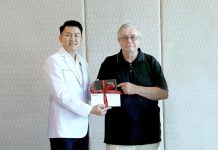I used that headline a few years ago now, but it seems nobody listened! Should I have shouted it a little louder? But jokes aside, deafness is an increasing problem in Thailand, a fact which is being acknowledged by the various noise abatement bodies in this country (and yes, amazingly there are some).
For some reason, noise seems to have become part of the local ‘culture’. How many times have you heard people screaming into their telephones? At volumes so loud they really don’t need the phone at all. Go into shopping centers and be physically assaulted by noise levels so great they approach the threshold of pain. I personally experienced one promotion for children that had passers-by holding their hands over their ears, whilst two screaming and amplified emcees exhorted the children to crowd around the stage (and its boom boxes). The damage to the hearing of young ears could be horrendous! Even walking down the street your ears are assaulted by not just motorcycles but slow moving promotional vehicles with mobile boom boxes to tell you all about the newest shopping center, where you can shop in comfort, other than unrestricted noise!
What does not seem to be understood by the public at large, however, is that hearing, like eyesight, deteriorates over time. However, damage the hearing early in life and when the hearing loss through aging is added to the hearing loss from noise exposure, you are guaranteed of increasing deafness as you get older.
What is not understood is that “noise” is not just measured by intensity, but it is volume multiplied by time of exposure. If the industrial noise level exceeds 90 decibels (dB) for a 40 hour week, this is known as a ‘noise dose’ of 1.0. If the noise level experienced by the unprotected ear was over 120 dB, then the ‘safe’ exposure was measured in minutes. And as an example of 120 dB, that is the level reached by an ambulance siren – or a rock concert. Other examples are the hammer drill that you use to drill holes in concrete which operates at 114 dB or a headset for personal listening at full volume, so the ‘safe’ level here is 15 minutes a day. Even a hand drill operates at 98 dB, so the unprotected ear should not be exposed to this level for more than two hours.
The noise induced deafness characteristically affects the hearing at 4 kHz first, and that is towards the upper musical ranges, and it goes on from there. If this noise induced hearing loss begins early in life, then the chances of the person ending up clinically deaf by the time he or she is 50 years old is very high.
So what can be done? Various research papers from around the world have managed to quantify the risk, and others have managed to show that the risk is perceived by older children and young adults, but they are not likely to do much about it. In some ways I can agree with them. Why bother going to a rock concert if you have to sit quietly to hear the music?
The Canadian Journal of Public Health looked at this problem and reported that 74 percent of rock concert attendees thought it was likely or very likely that noise levels at music concerts could damage their hearing, but only three percent wore hearing protection.
Dr. Jeannie H. Chung and co-workers from the Harvard Medical School found a few years ago that only eight percent of young adults thought hearing loss was a very big problem and yet most respondents had experienced tinnitus or hearing impairment after attending concerts (61 percent) and clubs (43 percent).
So we know the problem exists. We know the relative ‘safe’ levels of noise exposure, but is wearing ear protection the answer? Quite frankly, this is a classic example of the ambulance at the bottom of the cliff, rather than the fence at the top of the cliff. Preventive action needs to be done at the noise source. It is time for us to start shouting at the regulatory authorities! And keep your children away from noisy shopping center promotions!




